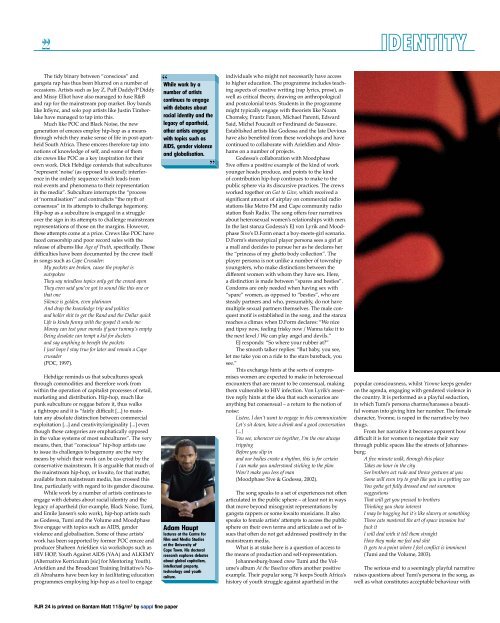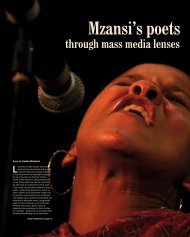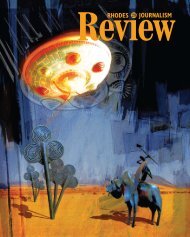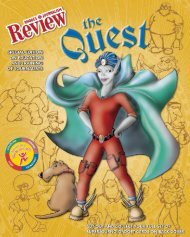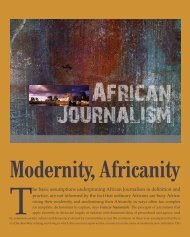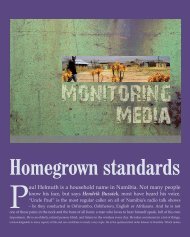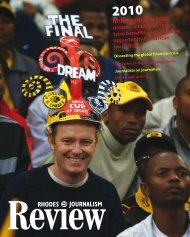FULL PDF - Rhodes Journalism Review - Rhodes University
FULL PDF - Rhodes Journalism Review - Rhodes University
FULL PDF - Rhodes Journalism Review - Rhodes University
Create successful ePaper yourself
Turn your PDF publications into a flip-book with our unique Google optimized e-Paper software.
22<br />
The tidy binary between “conscious” and<br />
gangsta rap has thus been blurred on a number of<br />
occasions. Artists such as Jay Z, Puff Daddy/P Diddy<br />
and Missy Elliot have also managed to fuse R&B<br />
and rap for the mainstream pop market. Boy bands<br />
like InSync, and solo pop artists like Justin Timberlake<br />
have managed to tap into this.<br />
Much like POC and Black Noise, the new<br />
generation of emcees employ hip-hop as a means<br />
through which they make sense of life in post-apartheid<br />
South Africa. These emcees therefore tap into<br />
notions of knowledge of self, and some of them<br />
cite crews like POC as a key inspiration for their<br />
own work. Dick Hebdige contends that subcultures<br />
“represent ‘noise’ (as opposed to sound): interference<br />
in the orderly sequence which leads from<br />
real events and phenomena to their representation<br />
in the media”. Subculture interrupts the “process<br />
of ‘normalisation’” and contradicts “the myth of<br />
consensus” in its attempts to challenge hegemony.<br />
Hip-hop as a subculture is engaged in a struggle<br />
over the sign in its attempts to challenge mainstream<br />
representations of those on the margins. However,<br />
these attempts come at a price. Crews like POC have<br />
faced censorship and poor record sales with the<br />
release of albums like Age of Truth, specifically. These<br />
difficulties have been documented by the crew itself<br />
in songs such as Cape Crusader:<br />
My pockets are broken, cause the prophet is<br />
outspoken<br />
They say mindless topics only get the crowd open<br />
They even said you’ve got to sound like this one or<br />
that one<br />
Silence is golden, even platinum<br />
And drop the knowledge trip and politics<br />
and holler shit to get the Rand and the Dollar quick<br />
Life is kinda funny with the gospel it sends me<br />
Money can test your morals if your tummy’s empty<br />
Being desolate can tempt a kid for duckets<br />
and say anything to benefit the pockets<br />
I just hope I stay true for later and remain a Cape<br />
crusader<br />
(POC, 1997).<br />
Hebdige reminds us that subcultures speak<br />
through commodities and therefore work from<br />
within the operation of capitalist processes of retail,<br />
marketing and distribution. Hip-hop, much like<br />
punk subculture or reggae before it, thus walks<br />
a tightrope and it is “fairly difficult [...] to maintain<br />
any absolute distinction between commercial<br />
exploitation [...] and creativity/originality [...] even<br />
though these categories are emphatically opposed<br />
in the value systems of most subcultures”. The very<br />
means, then, that “conscious” hip-hop artists use<br />
to issue its challenges to hegemony are the very<br />
means by which their work can be co-opted by the<br />
conservative mainstream. It is arguable that much of<br />
the mainstream hip-hop, or kwaito, for that matter,<br />
available from mainstream media, has crossed this<br />
line, particularly with regard to its gender discourse.<br />
While work by a number of artists continues to<br />
engage with debates about racial identity and the<br />
legacy of apartheid (for example, Black Noise, Tumi,<br />
and Emile Jansen’s solo work), hip-hop artists such<br />
as Godessa, Tumi and the Volume and Moodphase<br />
5ive engage with topics such as AIDS, gender<br />
violence and globalisation. Some of these artists’<br />
work has been supported by former POC emcee and<br />
producer Shaheen Ariefdien via workshops such as<br />
HIV HOP, Youth Against AIDS (YAA) and ALKEMY<br />
(Alternative Kerriculum [sic] for Mentoring Youth).<br />
Ariefdien and the Broadcast Training Initiative’s Nazli<br />
Abrahams have been key in facilitating education<br />
programmes employing hip-hop as a tool to engage<br />
RJR 24 is printed on Bantam Matt 115g/m 2 by sappi fine paper<br />
While work by a<br />
number of artists<br />
continues to engage<br />
with debates about<br />
racial identity and the<br />
legacy of apartheid,<br />
other artists engage<br />
with topics such as<br />
aids, gender violence<br />
and globalisation.<br />
adam haupt<br />
lectures at the centre for<br />
film and media studies<br />
at the university of<br />
cape Town. his doctoral<br />
research explores debates<br />
about global capitalism,<br />
intellectual property,<br />
technology and youth<br />
culture.<br />
individuals who might not necessarily have access<br />
to higher education. The programme includes teaching<br />
aspects of creative writing (rap lyrics, prose), as<br />
well as critical theory, drawing on anthropological<br />
and postcolonial texts. Students in the programme<br />
might typically engage with theorists like Noam<br />
Chomsky, Frantz Fanon, Michael Parenti, Edward<br />
Said, Michel Foucault or Ferdinand de Saussure.<br />
Established artists like Godessa and the late Devious<br />
have also benefited from these workshops and have<br />
continued to collaborate with Ariefdien and Abrahams<br />
on a number of projects.<br />
Godessa’s collaboration with Moodphase<br />
5ive offers a positive example of the kind of work<br />
younger heads produce, and points to the kind<br />
of contribution hip-hop continues to make to the<br />
public sphere via its discursive practices. The crews<br />
worked together on Got to Give, which received a<br />
significant amount of airplay on commercial radio<br />
stations like Metro FM and Cape community radio<br />
station Bush Radio. The song offers four narratives<br />
about heterosexual women’s relationships with men.<br />
In the last stanza Godessa’s EJ von Lyrik and Moodphase<br />
5ive’s D.Form enact a boy-meets-girl scenario.<br />
D.Form’s stereotypical player persona sees a girl at<br />
a mall and decides to pursue her as he declares her<br />
the “princess of my ghetto body collection”. The<br />
player persona is not unlike a number of township<br />
youngsters, who make distinctions between the<br />
different women with whom they have sex. Here,<br />
a distinction is made between “spares and besties”.<br />
Condoms are only needed when having sex with<br />
“spare” women, as opposed to “besties”, who are<br />
steady partners and who, presumably, do not have<br />
multiple sexual partners themselves. The male conquest<br />
motif is established in the song, and the stanza<br />
reaches a climax when D.Form declares: “We nice<br />
and tipsy now, feeling frisky now / Wanna take it to<br />
the next level / We can play angel and devils.”<br />
EJ responds: “So where your rubber at?”<br />
The smooth talker replies: “But baby, you see,<br />
let me take you on a ride to the stars bareback, you<br />
see.”<br />
This exchange hints at the sorts of compromises<br />
women are expected to make in heterosexual<br />
encounters that are meant to be consensual, making<br />
them vulnerable to HIV infection. Von Lyrik’s assertive<br />
reply hints at the idea that such scenarios are<br />
anything but consensual – a return to the notion of<br />
noise:<br />
Listen, I don’t want to engage in this communication<br />
Let’s sit down, have a drink and a good conversation<br />
[...]<br />
You see, whenever we together, I’m the one always<br />
tripping<br />
Before you slip in<br />
and our bodies create a rhythm, this is for certain<br />
I can make you understand sticking to the plan<br />
Won’t make you less of man<br />
(Moodphase 5ive & Godessa, 2002).<br />
The song speaks to a set of experiences not often<br />
articulated in the public sphere – at least not in ways<br />
that move beyond misogynist representations by<br />
gangsta rappers or some kwaito musicians. It also<br />
speaks to female artists’ attempts to access the public<br />
sphere on their own terms and articulate a set of issues<br />
that often do not get addressed positively in the<br />
mainstream media.<br />
What is at stake here is a question of access to<br />
the means of production and self-representation.<br />
Johannesburg-based crew Tumi and the Volume’s<br />
album At the Baseline offers another positive<br />
example. Their popular song 76 keeps South Africa’s<br />
history of youth struggle against apartheid in the<br />
popular consciousness, whilst Yvonne keeps gender<br />
on the agenda, engaging with gendered violence in<br />
the country. It is performed as a playful seduction,<br />
in which Tumi’s persona charms/harasses a beautiful<br />
woman into giving him her number. The female<br />
character, Yvonne, is raped in the narrative by two<br />
thugs.<br />
From her narrative it becomes apparent how<br />
difficult it is for women to negotiate their way<br />
through public spaces like the streets of Johannesburg:<br />
A five minute walk, through this place<br />
Takes an hour in the city<br />
See brothers act rude and throw gestures at you<br />
Some will even try to grab like you in a petting zoo<br />
You gotta get fully dressed and not summon<br />
suggestions<br />
That will get you pressed to brothers<br />
Thinking you show interest<br />
I may be bugging but it’s like slavery or something<br />
These cats mastered the art of space invasion but<br />
fuck it<br />
I will deal with it tell them straight<br />
How they make me feel and shit<br />
It gets to a point where I feel conflict is imminent<br />
(Tumi and the Volume, 2003).<br />
The serious end to a seemingly playful narrative<br />
raises questions about Tumi’s persona in the song, as<br />
well as what constitutes acceptable behaviour with


